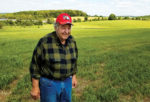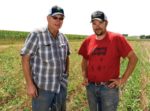Advertise Follow Us
Items Tagged with 'Yetter SharkTooth'
ARTICLES
From his first no-tilled acres to tweaking cover crops, working with a ‘No-Till Club’ helps Jim Riesberg forge ahead.
Read More
Getting More Dollars Per Acre With No-Till, Covers and Livestock
David Wessel’s recipe for no-till success lets him wring out profits from poorer ground and lean on covers and healthier soil to raise corn, soybeans and wheat more economically.
Read More
Healing the Soil Through No-Till, Focusing on Boosting Organic Matter
A combination of long-term no-till, cover crops, planting green and spreading manure brings organic matter levels from 2-4.8%.
Read More
No-Till Transition Succeeds Step by Step
The Forkner family is bringing productivity back to gently rolling hills by adding livestock and seeding cover crops to build soil health.
Read More
Hybrid No-Till, Strip-Till System Tackles Tough Residue Challenges
Two decades of reduced tillage have helped the Rotenberger family improve soil health and address some daunting residue challenges posed by their cropping rotations.
Read More
9 Growers Spill Their Secrets for Planting into Cover Crops
From tall, living covers to a heavy surface residue, no-tillers share how they adjust their planters and spring programs to work with cover crops.
Read More
15 No-Tillers Share Their Best Planter Tweaks, Upgrades
No-tillers take planter modifications seriously as they aim for optimum seed and nutrient placement for specific farm conditions.
Read More
Covers, Controlled Traffic Help Bring Clay Soils Under Control
Cereal rye and cover crop mixes, along with controlled traffic, are helping Tim and Carey Waltz improve their lake bed soils while increasing corn, soybean and wheat yields.
Read More















